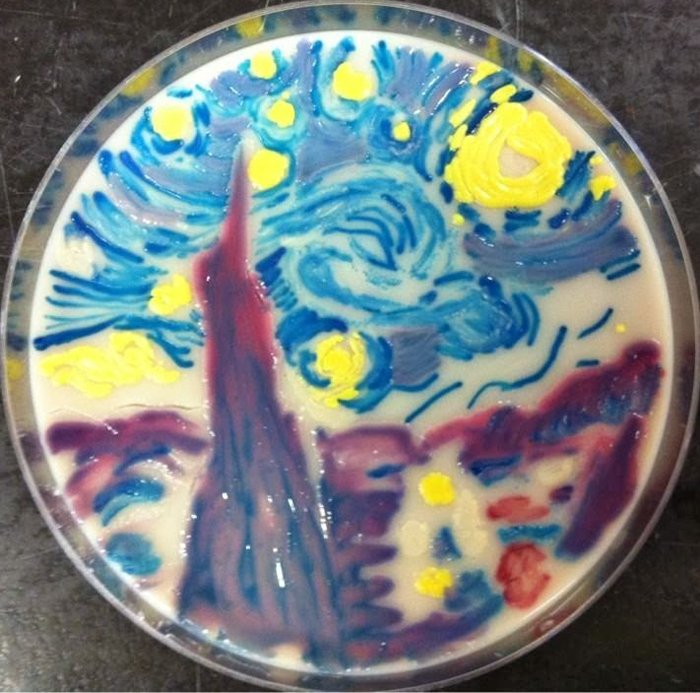Agar comes from red algae and is the jelly-like substance that lines Petri dishes used to culture bacteria. There are many different types of agar, designed for different purposed.
‘General media’ are non-selective, which means it should support that growth of a broad selection of microbial life.
Agar can have additional nutrients added, such as from sheep’s blood or peptone. These can encourage growth broadly or specifically, depending on the nutrient. From a personal perspective, I wish to avoid the use of animal products in my work as this would be incompatible with my vegan lifestyle. Although I recognise the impact of using live or dead animals in art (Damian Hirst; Guillermo Vargas) my belief is that artist can be creative enough to obtain such impact without the exploitation of animals. I do not feel that growing microbes for this project is incongruous here, because as single-cell organisms they lack the mechanics to be considered sentient, as defined by the Cambridge Declaration on Consciousness in Non-Human Animals.
Some microbes are most fastidious, meaning they require a specific environment/nutrients to grow, for example E. coli prefers saline agar. If these microbes are present in a sample but are cultured onto the wrong kind of media, it is likely I will see little, if any, growth.
Because I am taking environmental samples and don’t know what I may find, I feel using a general media is the best route to go down. I will seek a brand/formula that is nutrient rich but contains no animal products. James Redfern uses primarily blood agar in his research, and he has informed me that ‘Tryptone soy agar’ contains a nutrient derived from milk, though I have found an online seller who stocks ‘Tryptic soy agar’ that they claim contains no animal products (though I have requested that they check this is definitely correct- my feeling is they have likely made a mistake and Redfern has confirmed that ‘Tryptone’ and ‘Tryptic’ are the same thing). The brand Vegitone appears to be entirely animal-free. Redfern also mentioned Malt Extract Agar and Sabouraud Dextrose Agar but these are more suited to growing fungi than bacteria. I feel I am moving away from exploring fungi and instead will focus on other microbes and single-cell organisms such as bacteria.
Additionally, agar is used to study diffusion and molecular weight. A simple test involves dropping dyes with different molecular weights onto a Petri dish and observing how they move through the agar. This creates interesting results of different coloured ‘clouds’ of colour. There are also dyes specific to microbiology, which make it easier to view samples under a microscope. Some are florescent, and some will dye living and dead cells a different colour. The use of dyes to add colour and pattern to my plates is something I need to consider in my aesthetic strategy. It seems to make sense to use materials found in microbiology, although Redfern has informed me that the dyes will usually kill the microbes.
Finally there is chromogenic agar, which will change colour depending on which microbes it is exposed to, presenting an array of aesthetic possibilities! The image included in this post is by Amy B. of the Provincial Laboratory of Public Health in Edmonton, Alberta, Canada, who told microbiologist and educator Mark O. Martin on his blog:
“The van Gogh picture was created on Uriselect chromogenic agar which is a white colour. Different bacteria show up as different colours so the following were used:
– Pink=E. coli
– Dark blue= Enterococcus
– Light blue= Klebsiella pneumoniae
– Red= Serratia marcescens (this is actually its naturally occurring ruby pigment, not from the chromogenic agar)
– White= Candida albicans
– Yellow= Micrococcus luteus (again, this was it’s naturally occurring pigment not from the chromogenic agar)“I used a metal pick and a glass spreader to inoculate the plate approximately in the design of the picture, then incubated at 35℃ for 24-48 hrs and this was the final result!”
Early on in this project I considered making a microbe-solar-system, and after seeing this image I can see how that would be possible to do in a future project.
References:
Martin, M.O. (2014) Microbiology, creativity, and extra credit. [Online] Available at: http://microbesrule.blogspot.co.uk/2014/01/microbiology-creativity-and-extra-credit.html [Accessed: 21 December 2016].
NeuroVigil (2012) Francis Crick memorial conference 2012: Consciousness in animals. [Online] Available at: http://fcmconference.org/ [Accessed: 21 December 2016].
Sigma Aldrich (2016) Microbiology products. [Online] Available at: https://www.sigmaaldrich.com/analytical-chromatography/microbiology/microbiology-products.html?TablePage=18176518 [Accessed: 21 December 2016].
University of North Dakota (1997) Laboratory #4 – DIFFUSION & OSMOSIS. [Online] Available at: http://www.und.nodak.edu/dept/jcarmich/101lab/lab4/lab4.html. [Accessed 21 December 2016].
